The Last Supper , based on the masterpiece of Leonardo da Vinci, is unquestionably Andy Warhol’s greatest work. At the risk of being very ‘Warholian’, this is also “about as good an Easter theme as it gets”. Nothing therefore could then be more appropriate for today’s Easter Sunday cultural landmark occasion than a firsthand look on the relationship between Andy Warhol and Alexander Iolas, the svengali art dealer who discovered him and lovingly guided him throughout his career; a relationship dramatically culminating in The Last Supper series; a relationship that not only altered the course of History of Art but also changed our way of perceiving the world around us.
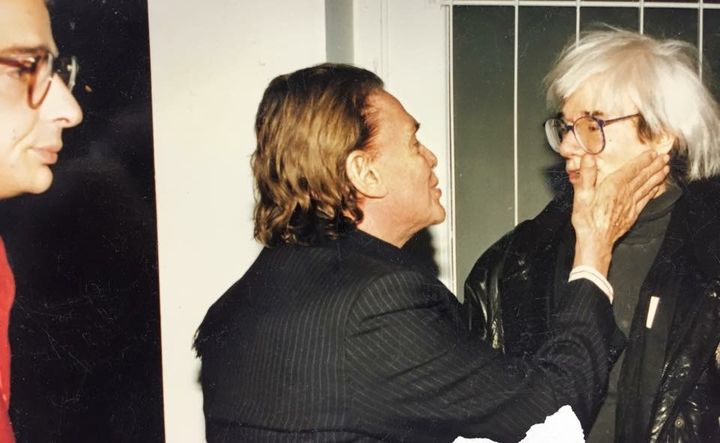
Iolas embracing Andy Warhol with an onlooking N. Stathoulis
In the Summer of 1979, while I was studying in London, Andy Warhol passed through the city taking the capital of Great Britain by storm. As newsstands at every corner were heralding the arrival of the “Warlock of New York’ I decided to go and meet him. Arriving at the lobby of the London Savoy I found it inundated by dozens of people in the hope of getting a glimpse of the world-famous artist. However, all were met by an army of bouncers who was there to politely fence anyone off. My surprise was great when , upon whispering two words to someone who looked as if he belonged to Warhol’s entourage, I was suddenly whisked off into an elevator, and led into a room in the middle of which stood none other than Andy Warhol himself. “And who arrrrre you to use that name?” asked the most famous man on earth with a slurred voice. “The godson”, I replied emphatically. “Oh !”, exclaimed He with a grin, “in that case let us offer you a drink. Lemonade?” After exchanging polite niceties for a couple of minutes he was hurriedly escorted out of the room. Alone, I sat pondering on the importance of my two words that had got to me to where I was sitting. They amounted to no more than a name: Alexander Iolas.
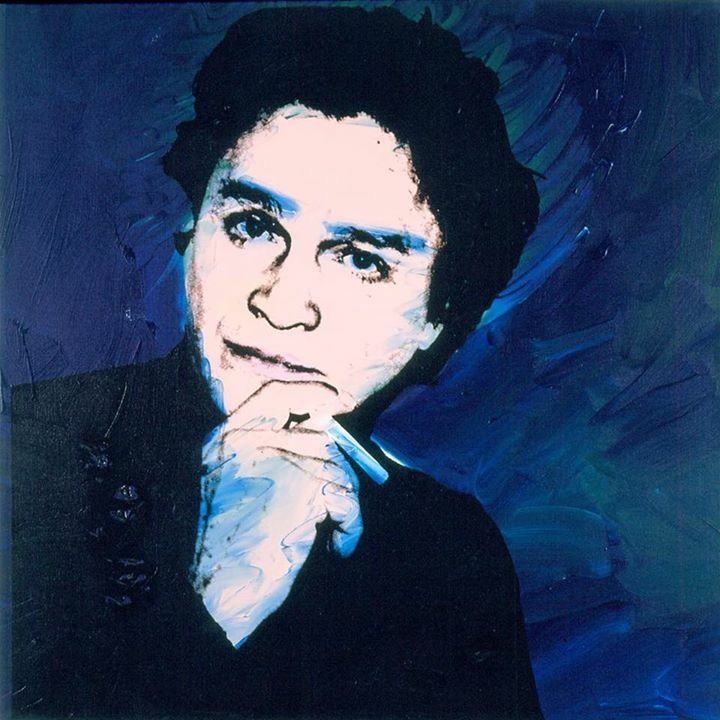
Portrait of Alexander Iolas by Andy Warhol
Born into a wealthy Greek family of cotton merchants in Alexandria Egypt, Alexander Iolas left his home at a young age to ‘conquer the world’.During his quixotic peregrinations across pre-war Europe he endeared himself to a impressive number of personalities ranging from Bertold Brecht to Pablo Picasso, Gertrude Stein and stage director Max Reihardt, to quote a few .. Having developed an eye for art he masterminded or influenced the careers of Max Enrst, Rene Magritte, Man Ray among many . Upon reaching New York in the 1930 s, he was responsible for introducing the Surrealists to America. By 1952 he became, on the recommendation of the cosmetics magnate Elizabeth Arden, the manager of the prestigious Hugo Gallery, owned by the grandson of the legendary French writer Victor Hugo.
Iolas’ official biographer Nikos Stathoulis shares with us a fateful afternoon at the Hugo Gallery:
A true observer of life, Iolas would enjoy looking from the window of the Hugo gallery at the passing crowds. The figure of a slim, strange-looking boy regularly walk on by would catch his attention. Till the day when Iolas stormed out into the street and asked the startled young man: “Where do you think you’re going?” .Pointing to a building across the street, the man answered that he was designing shoes for a company . Iolas responded by pointing to opposite the direction towards the prestigious gallery and walked off. A few days later, the shy young man appeared at the gallery door clutching a portfolio. It was series of designs of shoes adorned with butterflies, funky heels interspersed with written texts of Truman Capote. Upon reaching roughly the tenth drawing, Iolas reverted to his theatrical attitude- a trademark of his successful career : rising from his chair, he buttoned up his blazer and pausing, exclaimed in a stentorian manner: “ Dear Sir, till this day you were a shoe designer. As of this moment, you have to start working on your own one man show at the Hugo gallery”. The show occurred in May 1952, the young artist was Andy Warhol and the rest is well-known history.
THE MAKING OF THE FIRST GLOBAL GALLERY-OWNER
The German occupation of Paris during the Second World War sealed the fate of the city as artistic capital of the world in favor of New York.
Iolas quickly realized that in the post-war world there could no longer be a single universal artistic center dictating trends. The advent of the jet age, replacing travel by railway and ocean liner, brought about an unprecedented mobility not only of people but also of ideas. Within a short time span, an artist could be presented in various cities with a prestigious international coterie flying in to attend shows adding glamour and panache to local elites. Adding further glamour to glitz, Iolas would sprinkle his gallery openings with celebrities of the magnitude of Tennessee Williams, Marlene Dietrich and formidable opera diva Renata Tebaldi. This group would be called the ‘jet set’and Iolas made sure that their pet artist would be no other than Andy Warhol.
Having entered into silent partnership with his brother-in-law and cotton-king of America Arthur Steifel, Iolas became in the late 1950 s and early 1960 s the first global gallery owner ever. He would strategically select the cities in which he would deploy galleries according to very specific criteria: Paris for its artistic legacy, Geneva for the banks, Milan as an industrial hub and opera capital of the world and New York- “well…. as a miracle, the center of everything!”
As every gallery bore his name, Iolas created his own image, which became larger-than-life marked by contradictions between traveling on economy on commercial flights or in Steifel’s private jet and having the control tower at Orly airport (the then Paris international airport) giving clearance for landing for “Monsieur Iolas”. It was in the midst of this new era which was celebrating the end of hostilities and the creation of a new Europe that would end all wars that Iolas displayed his extravagant lifestyle among friends that included France’s president Georges Pompidou and industrialist Giovanni Agnelli. It was in this constantly changing world that Iolas wanted Andy to dominate.
And dominate he did. For who could have thought that Warhol’s multiples would one day come to define a national American style in which ordinary supermarket products such as detergents and cans would prominently figure in museums alongside the works of Picasso and Dali. A style that would be adopted and be loyally defended by future generations of artists.
MOVING ONTO HIGHER SPHERES
Mr. Stathoulis continues:
By 1971, Andy began selling at Sotheby’s. Hitherto his subject matter was brands and movie stars . It was around that time when Ioals lashed at him: “ What are all these figures you waste so much paint on? These nobodies of world history! Great painters like yourself should deal exclusively with great men, men who changed the course of History such as Karl Marx and Lenin. Great stars truly worshiped by millions of people whose lives they’ve influenced. Unless you’re strictly dealing with Garbo or Marlene – of course ....! “
Iolas’ references to communist leaders was certainly not out of context with the times. Politically, the post-war world was split by the Cold War- the stalemate between Socialism and Capitalism. Then, suddenly, President Nixon’s groundbreaking 1972 visit to China occurred opening up China, the most mysterious and distant of all socialist countries. As world attention focused on China, the one figure that stood out was no other than Chairman Mao.
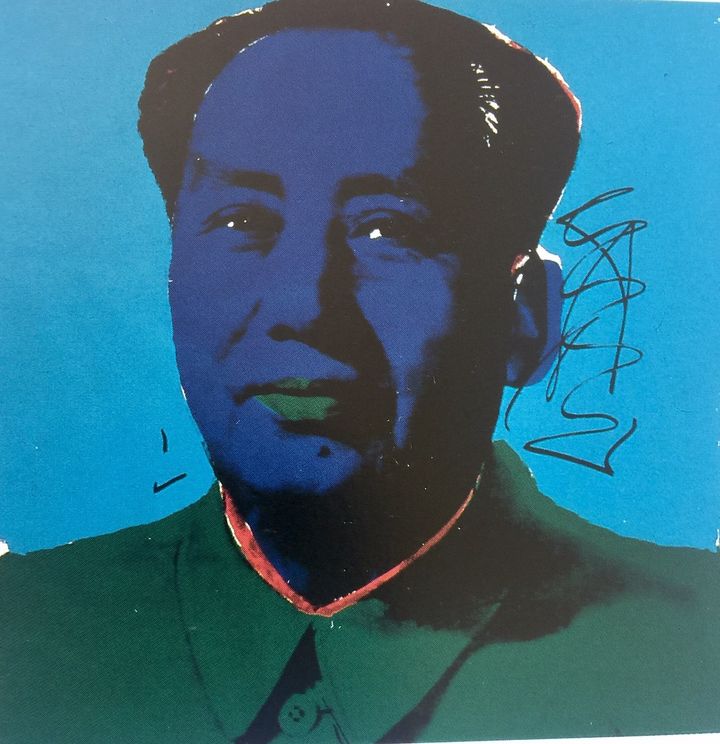
Chairman Mao
Warhol’s portrait was based on the photograph of Chairman Mao that was featured on the cover of “The Little Red Book”, the pocket-size edition of the leader’s quotes which, published in the hundreds of millions, is, to this day, still considered as one of the most potent tools of political indoctrination manuals of all times. Mass appeal, power, and a famous name were once again the ingredients for a new concept of the Warhol magic. Mr. Stathoulis :
The results of the Mao series were staggering .Though Andy still used the same technique as with his other, Hollywood portraits, an iciness and rigor pertaining to despotic rulers seemed to be coming out of the paintings reminding portraits of similar personalities by classical artists such as David.
Daniela Morera, responsible for the European publication of Interview Magazine and one of Andy Warhol’s closest friends explains:
Contrary to popular opinion, Andy was extremely well- trained and knowledgeable in the classical arts. He was careful, however, to keep this ‘academic’ aspect of his under low profile, as he never wanted to upstage anyone from his entourage, his clients or even his public. He could therefore very easily rise to the occasion, every time the opportunity of doing something different came along his way, as his portraits of rulers testify.
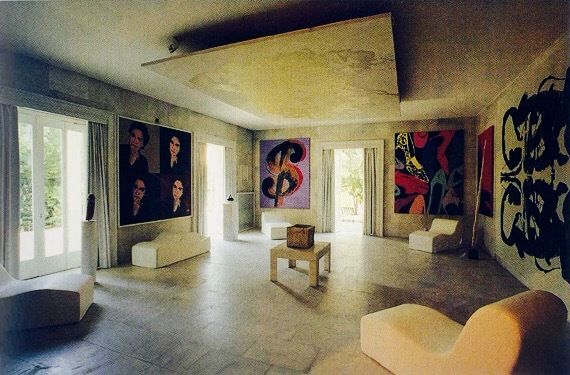
The ‘Warhol Room’ at the Iolas house of wonders
The respect Iolas had for Andy Warhol’s work is further testified by Mr. Stathoulis:
Indicative of this obsession with Andy was the fact that in Iolas’ house of wonders several rooms were dedicated to distinctive historical periods , such as the Gothic room, or to specific artists such as Matta or Max Ernst. Even so, the Warhol room stood out, for among huge dollar signs, soup cans and of course Iolas’ portrait in four multiples this was the only room that hosted a painting on the ceiling. This was one of his more abstract concepts belonging to the the so-called diamond dust paintings, which was literally looking down at you from the ceiling. (The artist is said to have rendered this technique popular by having low-grade diamonds ground into dust to form a paste that once/when applied on canvass would produce astonishing sparkling effects). Proudly pointing to this ‘plafond’ Iolas would always say: “This is where Andy’s work truly belongs, in heaven!”
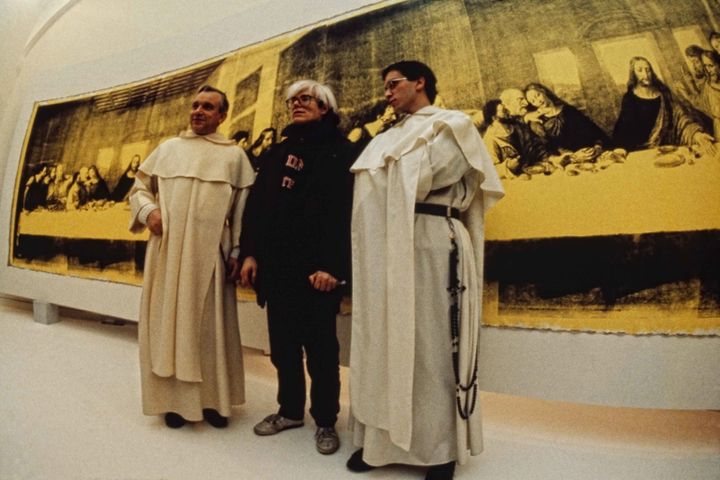
Warhol’s Last Supper receiving the blessing by the Dominican Priests of Santa Maria delle Grazie , the church that hosts Leonardo’s original mural.
THE ROAD TO “THE LAST SUPPER”
The last collaboration between Iolas and Warhol was The Last Supper. By an eerie twist of fate, neither of these two men could have imagined when setting off that this would be the last project they would undertake.
Throughout his career Warhol worked with themes; be they flowers, soup cans, personalities or more technical entities. These series would establish themselves by repetition, where one work would differ from another by a slight difference in color or inking . He sanctified consumerism and although The Last Supper series is taking a sanctified subject and dealing with it in a consumerist point of view, it was nevertheless marked by a novel concept.
Iolas considered Leonardo the most important personality ever to have lived. To stress this fact he would launch himself into Socratic soliloquies on the impossibility of fearing death, as he was convinced that upon reaching the other world he would encounter Leonardo and fall to his knees as a mark of respect.
He then began fantasizing about Warhol undertaking Leonardo’s Last Supper. The work would be conceived in the habitual form of multiples.
Annika Barbarigos a close collaborator of Iolas throughout the Last Supper period recalls:
What we have inherited as The Last Super series is in fact two distinct sets of works. When Iolas first mentioned the subject, Andy’s initial reaction was to work from a few small Christian votive statues he had purchased at some tourist shop in Little Italy.
Approaching The Last Supper theme in his usual manner- using mass-produced objects as subject matter- in this instance wasn’t successful. . Upon seeing the first series, Iolas discarded it in one stroke. Miss Barbarigos proceeds:
I still remember Andy shell-shocked by this rejection. Nevertheless, he immediately set to work using the original da Vinci mural as his inspiration. And what a difference this made: he produced fine lines that went beyond his until then social iconography leading him into the realm of the truly inspired. It has therefore become very important in the art world to define whether a work from The Last Supper belongs to the first or the second series. Miss Barbarigos concludes
He told Andy not to take this as a rejection but as his chance to attain the divine.
Daniela Morera, adds:
In private, Andy was a deeply religious person. Therefore his first choice of approaching the Last Supper from votive statues bought in a store was not so much a Pop Art prerogative but an extremely personal experience. This was how he would have approached the Last Supper as a worshiper. Needless to say that when he started working on the second series from direct observation of Leonardo’s masterpiece he was thrilled. Combining his piety with his great understanding of old masters brought about one of the highlights of 20th-century art..
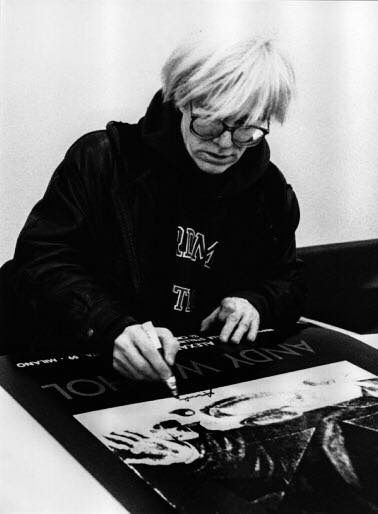
Andy at work
Mr. Stathoulis recalls:
From that moment on Andy submerged totally into his work. The two of them would meet regularly as Andy would produce a prolific amount of work in short time. Background colors took primal importance. Iolas wanted some of the works to be infused with very strong hues, even with fuchsia to give gay overtones, a suggestion which took even Andy aback. The creative energy of these months was unbelievable. And as for the results.........

The Last Supper poster
“ONE OF YOU SHALL BETRAY ME” – JESUS
By 1983 Iolas was very disappointed with Greece, the country which he had selected as home and where he had a large villa built which housed one of the most important modern art collections in the world, a collection of 20th-century masterpieces masterfully displayed alongside classical antiquities. False accusations of looting of antiquities spiraled out of control with the then nascent yellow press of the country literally feasting on his eccentric lifestyle and dragging his name into the mud. -N. Stathoulis
Iolas’ choice of da Vinci’s Last Supper’ was therefore quite symbolic of his frame of mind. The original work itself is a very dramatic piece. It depicts, in life size, the moment when Jesus announces to the apostles his imminent betrayal by one of them. In a scene filled with dismay and utter confusion, da Vinci explores their immediate reactions to this grave statement in a variation of pauses that range from astonishment, to anger and even horror, making this one of the greatest masterpieces ever created. The cinematographic possibilities of isolating fragments from this larger-than-life ensemble in order to explore these moments artistically and psychologically allowed Andy to take his serial painting to levels never before attained.
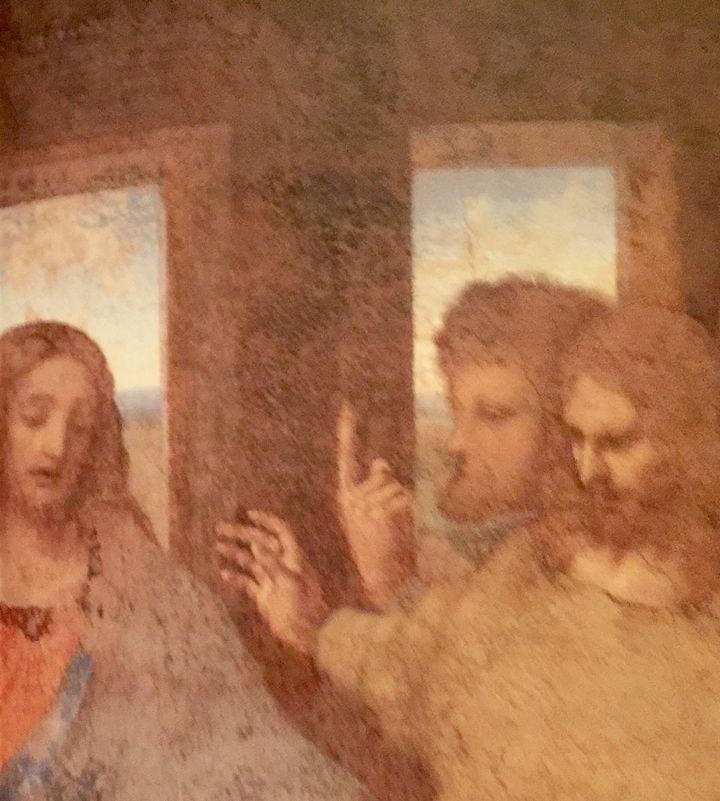
The Judas episode from the original mural
Mr. Stathoulis:
Embittered by his own betrayal Iolas was asking Andy to keep Judas out of the picture – I mean literally out: by leaving on the canvass the position of Judas vacant, Andy could later replace him by some allegorical figure which then Iolas would have named “the Greek traitor”. Warhol fiercely argued that omitting Judas from the narrative of the Last Supper would have wreaked havoc to the story. Judas therefore remained in the picture…
Central to the exhibition at the Palazzo delle Stelline was a huge thirteen-meter-long canvass, depicting the da Vinci scene in its entirety. The whole surface of the picture was covered with a military-like camouflage pattern which made the work stand out from the rest.
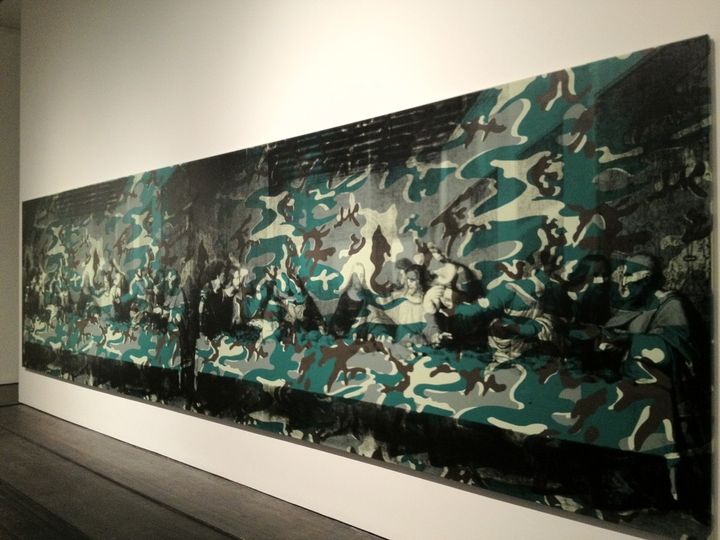
The ‘camouflaged’ Last Supper
Mr. Stathoulis explains:
Andy had become obsessed with the theme of camouflage. “ We spend our lives in camouflage” , he would constantly argue, meaning that we are constantly trying to hide aspects of ourselves from the rest of the world. Make-up for him was also a form camouflage. So were his portraits of celebrities as he would purposely leaving things out while working on them. Then, this wonderfully enigmatic artist came up with this huge ‘camouflaged’ Last Supper canvass. However, he would avoid talking about it. I am therefore certain that disturbing as this mixture of religion and camouflage must have been for the public it must have felt extremely important to him. Had he lived longer, I am determined that his camouflage approach would have opened up a huge chapter in the History of Art.
Miss Morera adds:
‘Palazzo delle Stelline’ was not the ideal venue for this exhibition. However, the show were to celebrate the moving of the venue as headquarters of the Bank Credito –Valtelinese from which Iolas had secured the sponsorship of the event. Patronage was always very important for the arts. A few years later, Larry Gagosian brought back to Milan excerpts of the Last Supper exhibiting them to another, more airy, venue that furthermore offered views of Milan’s Duomo (the famous cupola of the cathedral that has come to symbolize the city). It was there, as I stood breathless at the sight, that I realized the magnitude and importance of this series
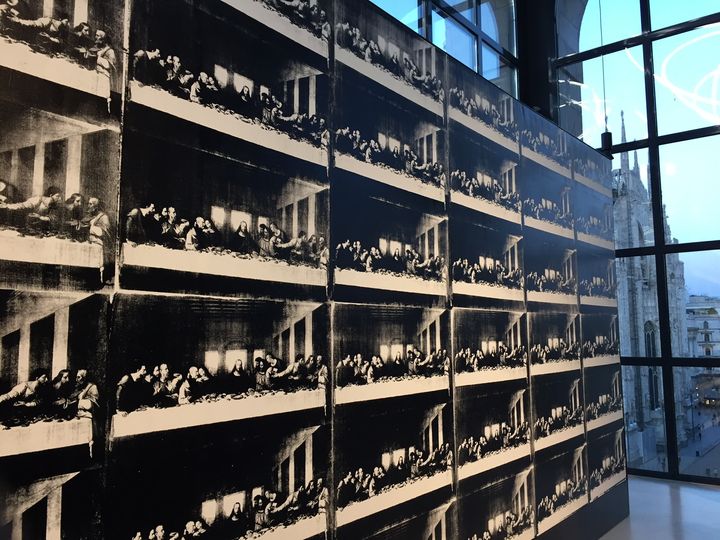
The Last Supper’s dramatic ‘second coming’ in Milan, brilliantly masterminded by Larry Gagosian
LA FORZA DEL DESTINO
Iolas adored ‘grand opera’ a love he quickly introducing to Andy. He was especially fascinated by the theatrical genre’s treatment of the theme of destiny: “The motivating force of any great opera that controls what is to happen in the future which lies beyond the influence of the characters” as his own mentor, legendary opera conductor Arturo Toscanini, had explained to him early on. For the greatest part of their lives both Iolas and Warhol had been influencers setting trends for people to follow. With the Last Supper, they felt as if they were tackling with forces beyond their reach, let alone their control.
The Mount of Olives is the dramatic peak of the Last Supper, the moment when a person is called to perform an act of self-sacrifice. It is a sad scene in which loneliness blends with the foreboding of what is about to be experienced in the near future resulting in the determination to follow one’s destiny and move on, regardless of what lies ahead.
During the final preparations for The Last Supper series both men seemed to have turned introspective as if something eerie was hovering above their heads. Iolas seemed especially tormented. A few days before their departure for Milan at the Factory while overseeing the works Iolas began to gaze at the void. He then quietly muttered : “The end is near….”. Disturbed by the gravity of his tone, Warhol fled the room. I tried patting Iolas on the shoulder, he brushed me off. He needed to be left alone with his thoughts. Still, little could anyone imagine that within a few weeks he would be further betrayed by the ones closest to his heart who, by obtaining a…, would place him in confinement condemning him to a solitary end in a New York hospital room.
APOTHEOSIS
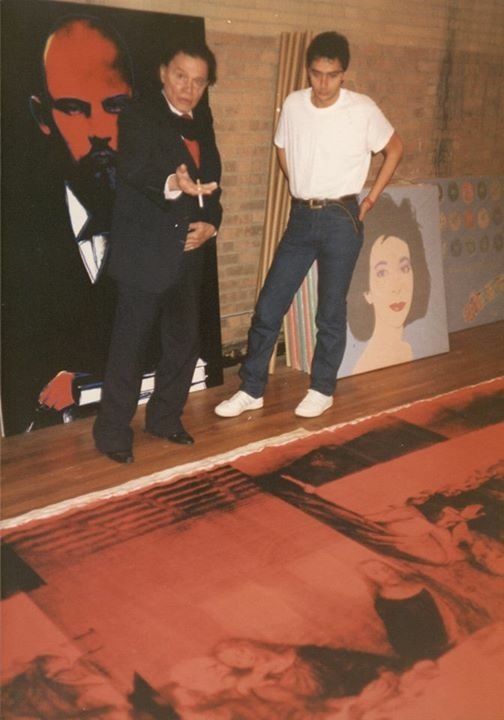
Iolas with N. Stathoulis overseeing the Last Supper’s finishing touches
Mr. Stathoulis concludes:
On the day of the show, banners were hoisted all over Milan announcing, in Italian, “Alexander Iolas presents Andy Warhol” . An overall celebratory mood seemed to have overtaken Milan as the city was taking pride in being the host of the double da Vinci’s Last Supper. By late afternoon , all roads leading to the exhibition venue were cordoned off by the police as crowds motivated by the unprecedented hype of the local media began descending in droves to catch a glimpse of arriving celebrities and the eccentric crowds usually associated with any Andy Warhol event. Iolas tough was nowhere to be found. He had been whisked off into a hospital launching thus a four-month-long grim chase of his traces across the globe, worthy of any Agatha Christie mystery and leading to his demise, in June of the same year.
Andy Warhol’s influence on younger generations can be echoed in the words of Dennis Koutoudis, LinkedIn expert CEO of Linked Super Powers and one of the world’s most influential social media experts :
Andy Warhol’s famous quote “In the future everyone will be world famous for fifteen minutes” became a motto that extraordinarily sensed the directions in which the world was changing. It in fact predicted the advent of social media . This is the world that Andy has forged for us and in which we are bound to spend the rest of our lives.
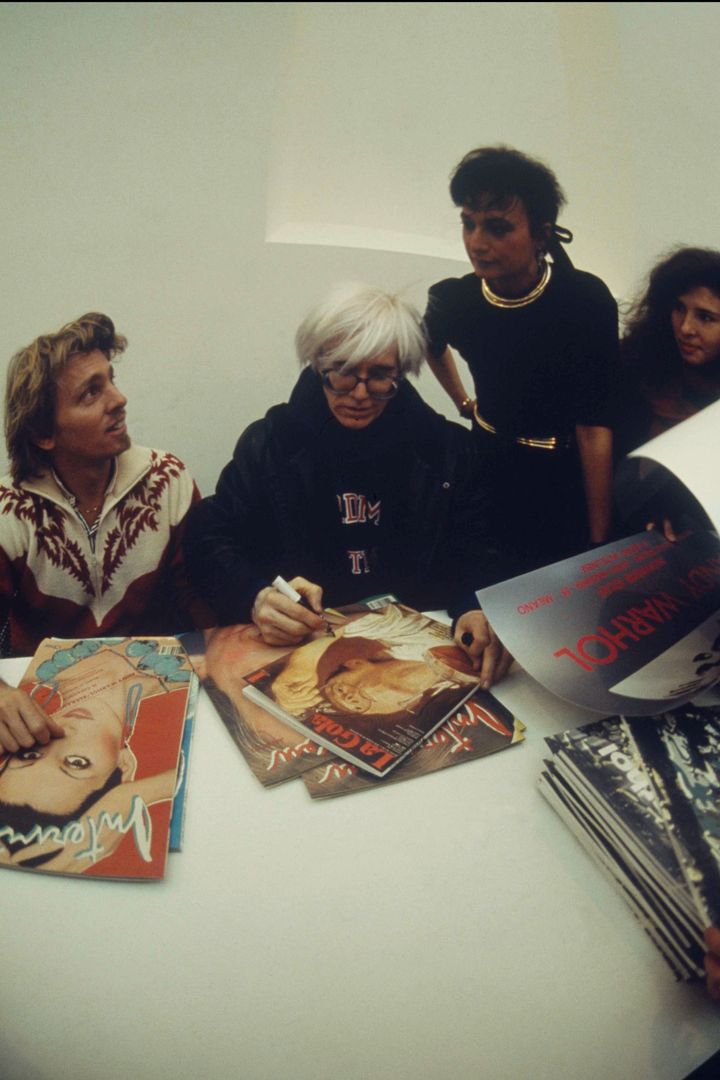
At the historic opening: Andy Warhol,flanked by Christopher Makos and Daniela Morera, signing autographs away. .
The Last Supper was the glorious conclusion of a 35-year-old collaboration and above all of a close friendship between the two men. It certainly contributed in redefining 20th-century art.We could only conclude our tribute on these two men who loved life and a good time with a brief account by Miss Morera of that historical opening of thirty years ago in the city of Milan
The capacity of the venue was of about 500 but people turned up by the thousands. Young people: students, high-school kids who heard of The Last Supper and wanted to witness history and be close to the man they considered as their own prophet. It was a pilgrimage ! Andy, who was always generous with his time and autograph signing, surpassed himself on the occasion. We had ordered hundreds of posters from New York. They were gone in a matter of minutes. Then Andy grabbed a marker in his hand and began signing on shirts, ties, jeans. Rarely has their been such electricity at an event. What a ‘gran-finale’ for such a wonderful person and such a truly unique life !!!
